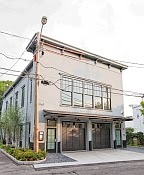Firehouse Redact
I have been reading a great deal of and about Henry James recently and just finished Colm Toibin’s The Master, his virtuoso fictional biography of James, with the result that I am more acutely attuned than usual to the powers of place. So maybe it’s just me, but it does seem that some spaces have lives of their own, with their own consciousness, exerting their own influence on the human activities occurring within them. Not a haunting, exactly, but a living, breathing entity giving shelter and replenishment to those who enter. Take, for example, the old firehouse in Sparkill, an unprepossessing, two-story building tucked between a mechanics garage and a former dry cleaning establishment on a snippet of a street that also once had within my own living memory a shoe repair place, long since gone. Gone as have many businesses come and gone since the shuttering of the Sparkill train station over fifty years ago. The old firehouse, however, is a place that insists on living.
A friend and I were looking for a writing studio, someplace where we could spread ourselves out and leave a mess until the next time, so we went to visit the firehouse in its new iteration as the Union Arts Center to see if they had that sort of space. Simon Basner, the new owner, greeted us on our arrival and struck us as a person who took thoughtful care of himself—he appeared fit and disciplined yet warm and expansive—at one with the place he was about to show us.
The building was originally a barn, built in 1876 by David W. Kipp, a successful grocer and tenth generation resident of the area, for use as a livery and carriage house. In 1899, a catastrophic fire at St. Agnes Convent and Orphanage brought home to Sparkill the necessity of having its own fire company, as did Tappan, Nyack and Piermont; thus, in 1901, the John Paulding Engine Company #1 was formed and subsequently incorporated in 1912. The carriage house was purchased in the same year from Donald Kipp’s estate. Its first truck was a horse-drawn, hand-powered pumper and then the building was upgraded in 1914 to accommodate a new motorized hose truck.
Even from the beginning, the engine company, when not fighting fires, made the building available for community events such as dances, weddings, minstrel shows and vaudeville. In 1906, it organized a circus to benefit victims of the San Francisco earthquake. The engine company, the building, and the community continued on in this way until 1970, when the engine company moved to its present location on Rte. 340. The next twelve years saw a series of short-lived businesses take up residence in the empty building: dress assembly and manufacturing, toy and statue manufacturing, an environmental safety laboratory and a vitamin store.
Then in 1982, the Firehouse Craftsmen acquired the building and established an arts and crafts cooperative based on the teachings of G. I. Gurdjieff, the founder of The Institute for the Harmonious Development of Man. Its members studied craft and its relation to self-knowledge. On the lower floor, they engaged in fabric design, woodworking, weaving, ceramics, stained glass and toy design and on the upper floor they practiced movement exercises designed to heighten self-awareness and vitality. In 2011, the Craftsmen left and the building was acquired by Mr. Basner, which brings us back to our tour.
We began on the ground floor. It was at once evident that he has respected the space. The reason we saw no pole was that the firemen used the stairs, like everyone else, but the cobbled interior tracks guiding the parking of the fire trucks remained embedded in the polished concrete. The first floor space was casual, including a kitchen for catering events. Behind the kitchen, we found what felt like the heart of the building, a room completely apart, serene in its atmosphere of spirituality that even doubters noticed. It emanated such a strong sense of ease that we sat down on a carved oak bench and lingered, almost forgetting why we had come.
Then Mr. Basner took us upstairs. On emerging from the stairwell, we were struck by the quality of the light flooding through tall windows. The space was large but not overwhelming and done in exquisite taste marked by a warm simplicity. There wasa stage at one end, and comfortable lounging at the other. The bathrooms were so lovely, you wanted to go in with all your possessions and lock the door against the world. As impressed as we were with the space, it was not suitable for what we wanted but it was clearly perfect for a great variety of other endeavors—performances, classes, exhibitions and gatherings and it was with reluctance that we left.
Mr. Basner’s visionary groundwork has created a renewed center for the practice and appreciation of the arts, and the old Sparkill firehouse with all its history stands strengthened and refreshed to begin its second century as a hub of creative and social endeavor.
For information about the calendar of events or scheduling your own, go to www.unionartscenter.com


